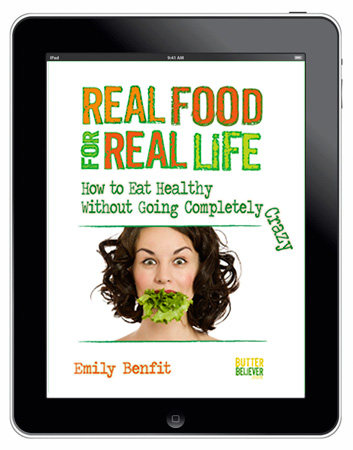I’ve got some news: we’re bringing back weekly Q&A!
I was getting a little overwhelmed with all the questions for a while there, and so I’ve been mostly handing them off to all our Facebook friends to help answer them. Which is great—I love the team effort! But I thought for ones which I really want to give my $0.02 and provide a more in-depth answer myself, I could start answering them as a blog post. That way, they will be easy to refer back to if others ask similar questions in the future, and eventually we’ll have a whole directory of Q’s & A’s for anyone to search through. Sound good? Let’s get started!
Question of the Week
Kimberlee asks:
“Does this help anyone who has absolutely zero access to grass-fed and/or raw anything? It is illegal in my province to have raw milk / butter / cheese (which I grew up on quite healthily, thankyouverymuch lol), and grass-fed meat is in the stratosphere with no wiggle room in the budget for it. Can someone who only has access to ‘regular’ groceries have any success? I feel quite discouraged…”
(This question was asked in regards to my ebook, Real Food for Real Life: How to Eat Healthy Without Going Completely Crazy)
I know the feeling! For several years, I lived in Hawaii with absolutely no access to raw dairy and limited availability of grass-fed meats. Real food is rough in lots of places. But that doesn’t mean you have to totally give up on improving the quality or sustainability of your diet.
For me, it became a matter of prioritizing certain foods over others, compromising where it made sense, and allowing myself flexibility and permission to not eat “perfectly.” I stopped buying produce items listed on the EWG “Dirty Dozen,” and more from the farmer’s market—especially cheap things like potatoes and bananas—and went ahead and bough conventional produce from the “Clean Fifteen” list. I sought out grass-fed, local dairy, even though it wasn’t raw. I bought organic whole chickens from Costco, and used up every last bit of them by making a couple batches of bone broth from the bird. Most of the grass-fed meat I ate was cheap—ground beef, and I even found a source for grass-fed organ meats—which were intended to be pet food! But I discovered that adding liver and heart to my ground beef, which were both less than a couple dollars a pound, was a great way to make it stretch, and add more nutrition to boot.
Most importantly, I decided to streamline my “eat this, not that” standards—what sorts of “real” foods I deemed essential, and which ingredients I definitely wanted to avoid.
There are really only a few things available in our modern food system that I actually consider harmful enough to actively avoid. On my “shortlist:” (This is taken straight out of Real Food for Real Life).
- Polyunsaturated fats, or PUFAs. Omega-6, specifically. In industrially-processed foods.
- Chemicals, which would include not only the thousands of chemical additives (preservatives, colorants, flavors, etc.) in processed foods, but artificial neurotoxic sweeteners, synthetic vitamins, and the chemicals used in industrial agriculture, such as chemical fertilizer, pesticides, and herbicides.
- GMOs, ‘nuff said.
- Factory-farmed animal products, ditto. Read this post for more on why I think it’s better to avoid meat, than it is to eat CAFO meat.
As for my real food essentials? Well, I just try to do my best to include as many “superfoods” as possible, and let the rest fall where it may. I know that word is majorly overplayed in the nutrition blogosphere these days, but I think it’s justified for some of the prized foods we consider to be most important. Things like:
- Organ meats, particularly liver
- Bone broth
- Gelatin (learn all about gelatin powder here)
- Cod liver oil (find it here)
- Raw dairy (or at least pastured, but I know this one may not be an easy option for you)
- Butter (we like to abide by a little saying around here—”any butter is better than no butter!”)
- Coconut oil (find it online)
- Fish eggs (doesn’t have to be expensive caviar! Any fish eggs will do. Extremely nutrient-dense)
- Shellfish (you’re eating a whole animal, all the best parts included!)
- Eggs, particularly the yolk. It’s worth it to splurge on the best quality eggs you can find. Even the most expensive pastured eggs are cheaper than grass-fed meat!
I explain in Real Food for Real Life my little policy regarding the superfoods:
“I try to do my best to include these foods as regularly as I can. It’s kind of like nutrition “insurance,” and allows me to feel much more freedom in the rest of what I choose to eat. If these foods make up a decent portion of your diet, you can relax on how nutritionally-sound the rest of it is, in my opinion.”
Action Steps
- Learn how to save on your real food grocery budget by making as many things as you can from scratch. It’s the pre-made foods that really dig into the budget—even things like condiments and salad dressing, which you might not even have considered making yourself, are expensive to buy but cheap and easy to make.
- Buy in bulk whenever you can. Especially grass-fed meats! I really think bulk is the only way to go with this. If you take home a quarter of a cow, you’re getting all the cuts, including nice steaks and such, for often less than the price per pound of ground beef sold in markets.
- Get familiar with your local resources. Ask around and find out where the farmer’s markets are, google and Yelp for nearby health food stores, and check the following sites:
- RealMilk.com: I know you said that raw milk is illegal where you are, but there are varying degrees of legality when it comes to that. Perhaps retail and farm sales are illegal, but there might not be a law against herd shares, or maybe raw milk to be sold as “pet food” (wink, wink) is legal. Doesn’t hurt to check.
- WestonAPrice.org: Contacting or joining a local chapter of the WAPF can be a huge help in finding the best real food resources in your area.
- EatWild.com: Listings for local farmers, specifically for grass-fed animal products, and more.
- LocalHarvest.org: Listings for CSAs, local farms, and more.
- Craigslist! See how I’ve managed to use CL to help me in my real-fooding ways here.
- Become an efficient label reader! Not everything in a “regular” grocery store is off-limits. Try to avoid the “shortlist” stuff, but allow yourself flexibility.
- Find out what sort of things you can shop for online, if local resources are limited. The Village Green Marketplace is an excellent place to start.
- Don’t ever expect perfection from yourself. The mere fact that you’re reading this tells me that you’re already doing the best you can—you’re learning, you’re evolving, you’re actively opening yourself up to making changes—and that’s what counts. I always say that I don’t promote food restriction—only food education. Another quote from Real Food for Real Life:
“I just want to clarify that, right now, you are doing as good as you need to when it comes to this stuff. You’re educating yourself. You’re literally doing the best you can, with the knowledge you have. Even if you’re not going out and getting all the “right” foods right now, that is okay! If you’re not at a point where those things are feasible, simply make whatever changes that do fit your available resources (time, money, energy) and are most important to you.
Some of the biggest and most critical changes that occur when people switch to a real food lifestyle, aren’t the things they start doing, but what they stop. If you do nothing more than stop cooking with vegetable oil, stop drinking diet sodas, and stop buying fake butter, you have made HUGE improvements in the health of your diet! Without having to go out and add anything else to your normal routine!”
Recommended Resources
No surprise here, I’m sure, haha. Of course, I recommend reading my ebook, Real Food for Real Life: How to Eat Healthy Without Going Completely Crazy. Not to toot my own horn or anything, but, a lot of people who are in your exact same shoes have found it really helpful in making the transition to a healthier, real food way of eating, while maintaining (or regaining) their sanity in the process.
Right now, you can get the book for 40% off the list price—that’s $10 off. This special summer sale ends Sunday, June 30th, so you gotta hurry if you want to get in on the sale price!
Click here to order now and save 40%.
Thanks for your support, and please let me know if I can help you further.
Got a Question?
Send me a Facebook message, email, or comment below. I try to get to as many questions as I can, but it can take a while to sort through all of them. Thanks for your patience!






Curious as to where you found your grass fed organ meats as I am currently in Hawaii and feed my dog a raw diet… I have had difficulty finding sources!
This was my source:
http://rawpetfoodhawaii.com/
But I think I remember hearing from a friend that they stopped supplying… I’ll have to ask her and report back!
I just found your blog and would LOVE to know your source of organ meats on Oahu. Do you remember her name and/or have her phone number? I’m desperate…
Thanks!
Jen
I know, it’s basically impossible to find grass-fed organ meats on Oahu! I even called and asked Kualoa if I could make an order, and they just “don’t do that,” apparently.
See the comment above regarding my pet food lady. Not sure if she’s still an option, so if not, try going to Ala Moana farmer’s market, or Haleiwa if you’re north shore. Both have had grass-fed meats offered there and I know at least one will sell you organs. And, Whole Foods does offer at least chicken livers, but possibly others if you make a special order. Good luck!
Emily I think you are amazing – the way you can simplify all this, for all of us just starting out on this journey, is brilliant 🙂 thank you for helping us not to go completely crazy and just focus on the main things! with regards from Germany!
That just made my day! What a lovely compliment. Thank you so much, Rachel!
Kimberlee states that it is illegal for her to have raw milk, butter and cheese. That is not true, it is only illegal to sell or distribute milk. She needs to get in touch with a farmer directly and make arrangements, if she has the money join a cowshare or find a friend who knows. She can email me if she wants and I can see if I can hook her up with a mooshiner
It is true that it’s flat-out illegal in some areas, unfortunately. Herdshares are illegal in some states (and provinces) as well. But I agree, it doesn’t hurt to try to speak with farmers directly or ask around for fellow “moonshiners!” 😉
me again, you dont need to publish the comment, please but you can hook us up :o)
One-woman show over here, sorry for the delay!
The comment Rachel made took the words right out of my mouth after reading the question about finding raw milk/being illegal etc. I thought to myself that someone would go crazy trying to be perfect with this type of diet but you are able to simplify things in a way to avoid pulling our hair out. Thanks and good job.
If you are looking for a great source, Wagyu Grass-Fed beef has superior flavor and texture to other types of grass-fed meats, due to the marbling. Our farm in Florida (small, sustainable) is one of the few farms in the U.S. raising this type of meat. You can find us at Pasture Prime Family Farm if you Google it. We ship all over!